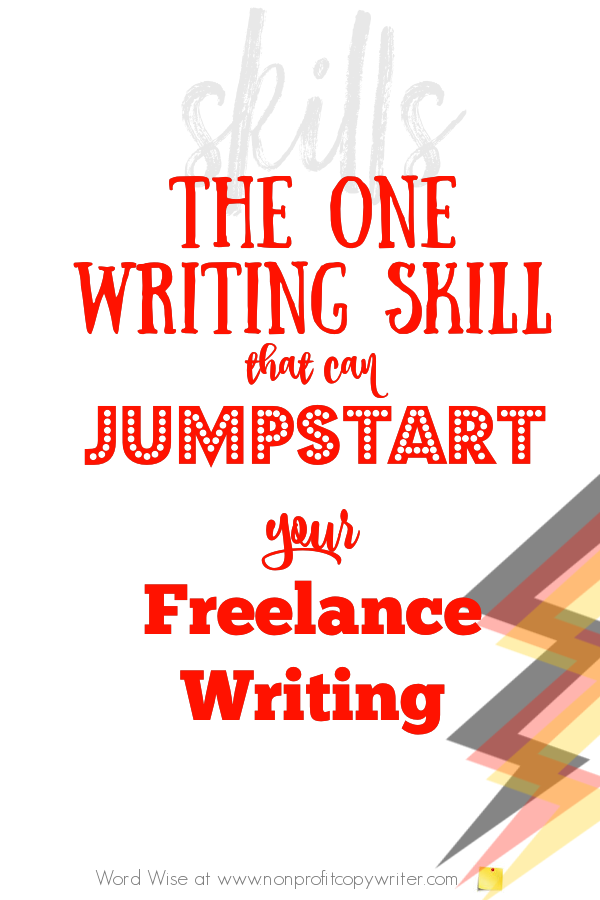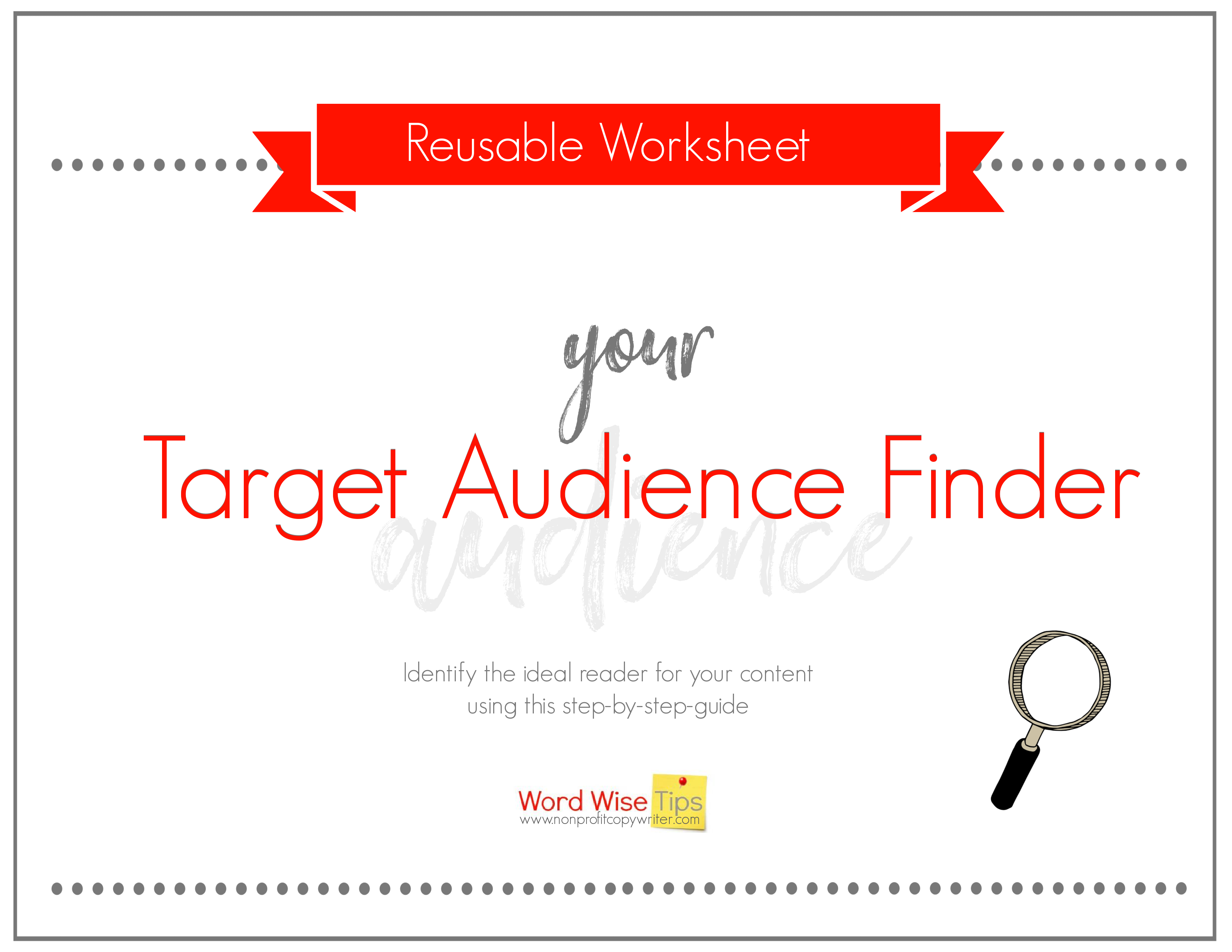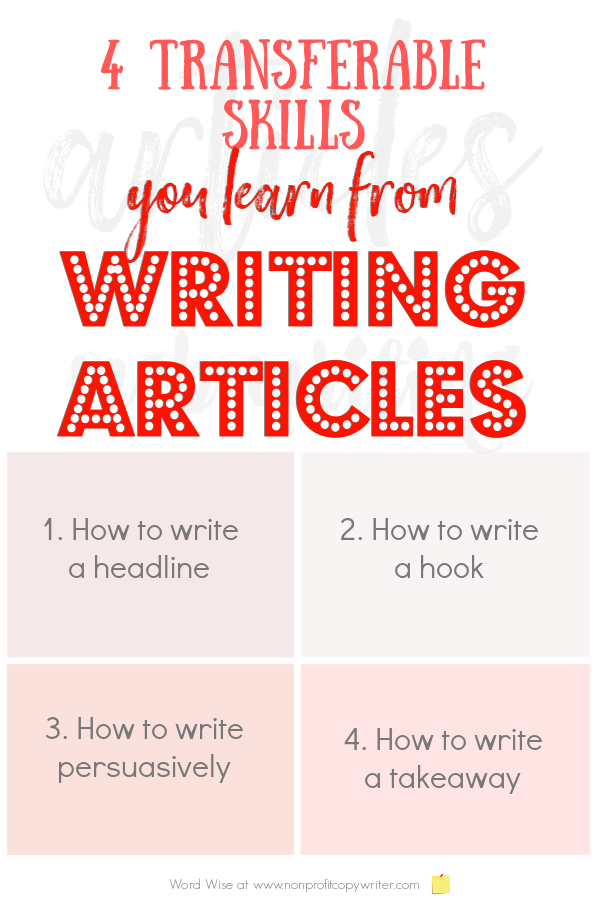Save Time: Get 5 Simple Writing Tips
you can put to use in 10 minutes
Learn To Write Content When You Learn To Write An Article
Award-winning writer Kathy Widenhouse has helped hundreds of nonprofits and writers produce successful content , with 750K+ views for her writing tutorials. She is the author of 9 books. See more of Kathy’s content here.
Updated 11.12.25
If you want to be a freelance writer who earns a good living from your words, you need to learn to write a saleable article.
An article? Print magazines and newspapers are folding. Online publications are swamped with queries. Why should today’s freelance writer invest time in learning to write a dying breed?
Because writing an article is a foundational skill that transfers to all different kinds of content. Learn to write an article and you’ll be able to produce high-quality blog posts, newsletters, brochures, grant applications, PowerPoint presentations, strategic plans, business plans, case studies, profiles, video scripts, white papers, books, eBooks, lesson plans, devotionals … pretty much any kind of content that a paying client will hire you to write.
Why an article is a cornerstone writing project
An article is not a collection of random thoughts that pour out of your pen spontaneously (that’s called brainstorming). Nor am I talking about occasional personal thoughts posted on a blog (that’s called journaling.) And I’m not referring to that bookmarked list of sites you’ve curated that provide fascinating information about raising ferrets (that’s called research.)
An article is a piece of writing that follows a structured format. It focuses on one main idea. The article explains that idea to the reader or persuades him to embrace it.
It’s a format that has a title, introduction, body, and conclusion. Each of these elements serves a specific function and contributes to the overall goal of the piece.
Furthermore, plenty of publications designate a specific word count for their articles. And if you want your article to sell to a publication or garner plenty of views, you need to target specific readers. Put all that together and that means a writer must be disciplined to produce saleable articles.
That is why writing an article is a cornerstone skill that opens the door to writing other kinds of content. Learn to write an article and you can write nearly any other kind of content. I know because I’ve done it.
Learn to write an article first
Years ago, I received a direct mail package that urged me to enroll in a course teaching me how to write an article that would sell.
I have no idea how I got on that particular mailing list, yet that letter opened a new world to me. I’d always been a reader, but I believed writing skills were bestowed by a special Writing Fairy at birth. Those blessed people ended up becoming journalists or writing the Great American Novel. Beyond that, I’d simply gained enough ability to write what I needed to pass high school language arts class.
Until that point, I didn’t know that writers could be trained. I could be one of them and learn to target a particular audience of readers … drill down to a main point … put together paragraphs to support that point, including quotes and other social proof … and wrap the whole enchilada in a tidy bow with a smart, snappy ending.
Nevertheless, I submitted the “suitability quiz” by return mail to the writing school. A few weeks later, I was invited to enroll in the course. For the next 12 months, I completed assignments and dutifully mailed them back to my instructor in 9 x 12 manila envelopes. (Email was in its infancy.)
My assignments were returned to me by snail mail with all kinds of red markings. But thanks to that course and a very generous one-on-one teacher assigned to me, I started making sales to magazines before I finished the course.
Use this fillable worksheet to identify the audience for a piece of content.
Writing an article is the foundation for writing other content
Today, I am convinced that by learning how to write an article, I acquired foundational skills for producing all kinds of content writing projects.
That groundwork grew into confidence, too. When a prospective client asked, “Can you write a newsletter (brochure, webpage, eBook, email series)?” my answer became, “Let’s work together so you can have what you need.”
Subsequently, I have had a lucrative second career that put our two children through college, paid their living expenses in graduate school, and gave my husband and me financial security. But it started by learning a handful of fundamental writing skills. You can learn those skills, too, when you learn to put together a well-written article.
Writing articles teaches 4 transferable skills
An article follows a structured format. It’s got a title. Then it opens with an introduction, followed by the body, and ties up neatly with a conclusion.
Sounds dry and unimaginative, right? Most foundational skills are. That’s why you routinely hear athletic coaches say, “We are focusing on the basics during training.”
Yet each of those four elements serves a purpose. When you learn to write an article, you learn to achieve each of those purposes with your words.
1. Write the title … and you learn to write a decent headline
Call it what you want — a title (for an article), a subject line (for an e-mail), a banner (in a newsletter), a teaser (a direct mail package’s outer envelope), a Johnson box (at the top of a direct mail letter), or even a caption (with a photo). No matter how you identify it, this short bit of text has an enormous responsibility. If this little group of words doesn’t do its job, then the rest of your piece won’t even get read.
A good writing instructor explains that you should write more than a handful of headlines before you choose one that’s most engaging. Take the article you’re reading now. I tried at least 17 options (or was it 26?) before landing on one.
Time spent on the headline does more for you than simply pull in more readers. A headline’s brevity means you need to summarize your article in a pithy 6–10 words. Learning to write a headline teaches you to distill your thoughts.
Spend time acquiring headline writing skills and you can transfer that expertise to writing subject lines that arouse curiosity and get the click. You can write captions that get more followers. You can write a book title that sells the book. And you‘ll learn how to summarize a main point succinctly.
2. Write the introduction … and learn to present a problem and a solution
You can call it the lead if you like. Or your introduction or hook. It’s the first few sentences of an article. And it must capitalize on all that goodwill you gained from writing an enticing headline. Now, it’s time to deliver by presenting a problem that’s near and dear to the reader’s heart … and a solution that actually works.
Here’s where you pull out a compelling story (“That one writing course opened the door to a rewarding second career for me …”). Or you describe the angst the reader might have over a certain issue (“If you want to be a freelance writer who earns a good living from your words, then you need to …”) But no matter how you open your article, you learn to identify who you’re writing to — in this case, would-be freelance writers who are willing to work hard at the craft to acquire skills that build a solid career.
Learn to write a first-class article and you’ll know you need to write to a specific group of readers in a particular kind of publication, whether it’s formal or informal, journalistic or academic, objective or opinionated. You’ll know to use attention-grabbing techniques at the top to rouse that particular reader’s emotions. Now he will keep reading.
Do that and you’ll be well on your way to writing effective appeal letters, direct mail, grant applications, job descriptions, book introductions, and of course news articles — all the different kinds of writing projects that open with the BLUF (Big Line Up Front) format.
3. Write the body … and learn to persuade with words
You’ve roused the reader’s emotion by presenting a problem that interests him and stating the solution. Now that he’s interested, you must strike surgically. The body of a well-written article convinces the reader that your answer works.
In other words, when you write a solid article, you offer evidence, statistics, authoritative quotes, anecdotes, solid reasoning, clear steps, events, documented proof, studies, and examples. You persuade.
Persuasion is not simple begging that pleads,” Please believe me.” Instead, it’s unshakeable proof that says, “I’ve given you my opinion — the solution or slant to answer the problem I presented in the introduction. Now, I’m giving you the facts to support that slant. If you’re smart, you’ll act on them.” In a typical article, that means at least three reasons why. Can be more, of course.
Think of the bulk of the slides in a PowerPoint … a grant application’s narrative … case studies … web pages … the middle 10 chapters of a 12-chapter book. Each of those projects is similar to the body of an article. Each makes the case for the problem and solution presented in the introduction. Learn to write an article, and you can write each of these kinds of writing projects, too.
4. Write a conclusion … and learn to write a takeaway.
Every piece of content needs a takeaway. And by that, I mean a bit of wisdom that stays with the reader … a chunk of information that changes how he thinks … or a call to action that he embraces and acts on.
Studies show that only 50% of readers stay with a piece of content beyond the halfway mark (at most.) They don’t expect memorable or useful content at the end. But they’ve stayed with you this long, right? By writing powerful endings, you give your faithful reader an unexpected bonus.
A decent takeaway is more than a rehash of everything you’ve already shared. When you’ve learned to write an article well, you give your reader a reward. You leave him grateful that he got beyond the headline and the lead and the content (even if he skimmed the subheads.) He has grown because of your article and now he is smarter or wiser or savvier or more inspired.
Learn to write a good takeaway and you’re all set to craft a powerful call to action, the moral of the story, a solid letter closing, or a clear response device that lifts returns — elements that are “conclusions” but are called something else in different kinds of content.
Learn to write an article and sharpen your writing axe
There are plenty of other skills you can acquire when you learn to write an article. There’s research … interviewing … analysis … editing … proofreading … query writing … pitching editors …formatting.
But the bottom line is this: when you learn to write a saleable article, you learn to organize writing projects. It’s a fundamental skill that may take some time to acquire. But if you want to write content and make money at it, that time is well spent.
“Give me six hours to chop down a tree,” Abraham Lincoln once said. “And I will spend the first four sharpening the axe.” Spend time sharpening your writing axe by learning to write a solid article. And then you will chop down plenty of trees much more easily and skillfully.
More Article Writing Tips
How to Write An Article: Get Started With These 12 Steps ...
The Foolproof Article Formula I’ve Used to Write 1,000+ Articles ...
How to Write an Article Introduction Faster ...
Writing Articles FAQs: Frequently Asked Questions ...
Wannabe Writer? Say Goodbye to Your Worst Enemy ...
How to Write an Outline: Article Writing Tips ...
The Inverted Pyramid: Article Writing Format for Online Content, Too ...
How to Create Valuable Content (Not Informational Junk Food) ...
8 Types of Leads that Pull in Readers ...
How to Choose an Article Topic...
Writing Articles Tips on our Pinterest board ...
Return from Learn to Write Content When You Learn This One Key Skill
to Nonprofit Copywriter home
As an Amazon Associate I earn from qualifying purchases.
Share This Page

Named to 2022 Writer's Digest list
BEST GENRE/NICHE WRITING WEBSITE


Stop Wasting Time!
Grab your exclusive FREE guide, "5 Simple Writing Tips You Can Put to Use in 10 Minutes or Less"














